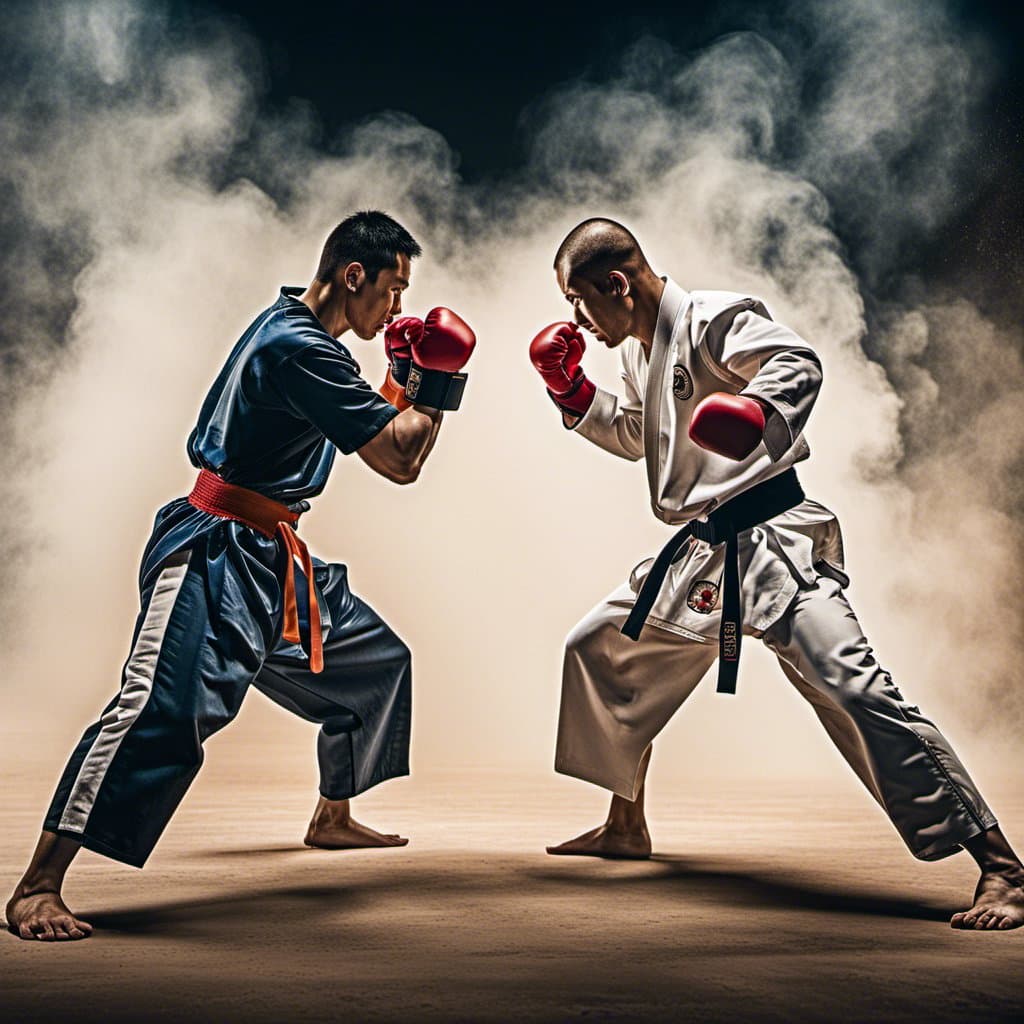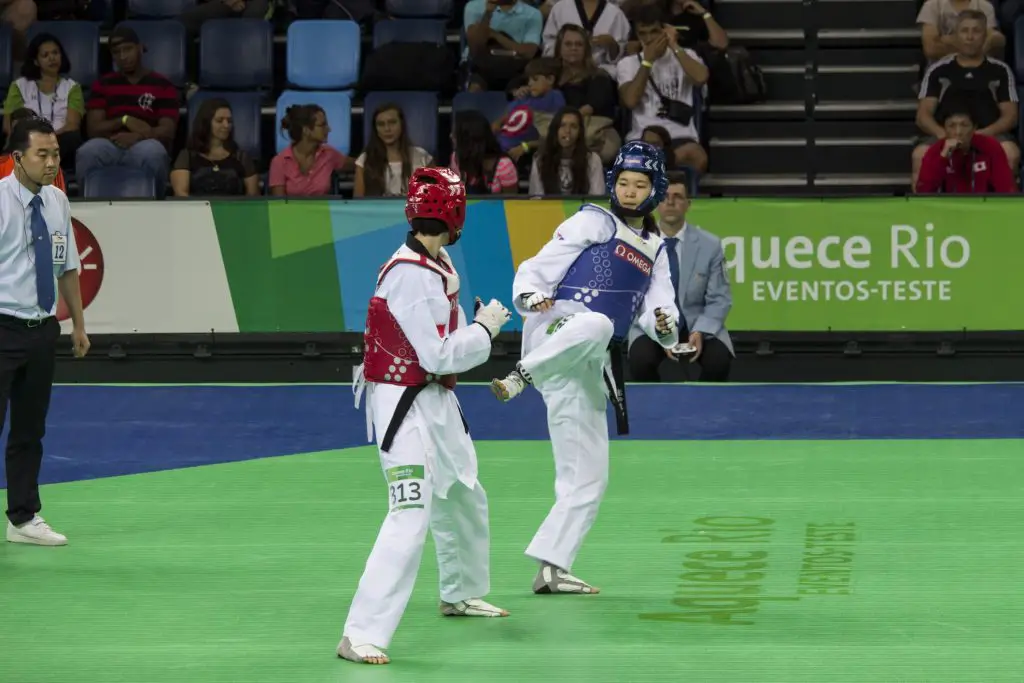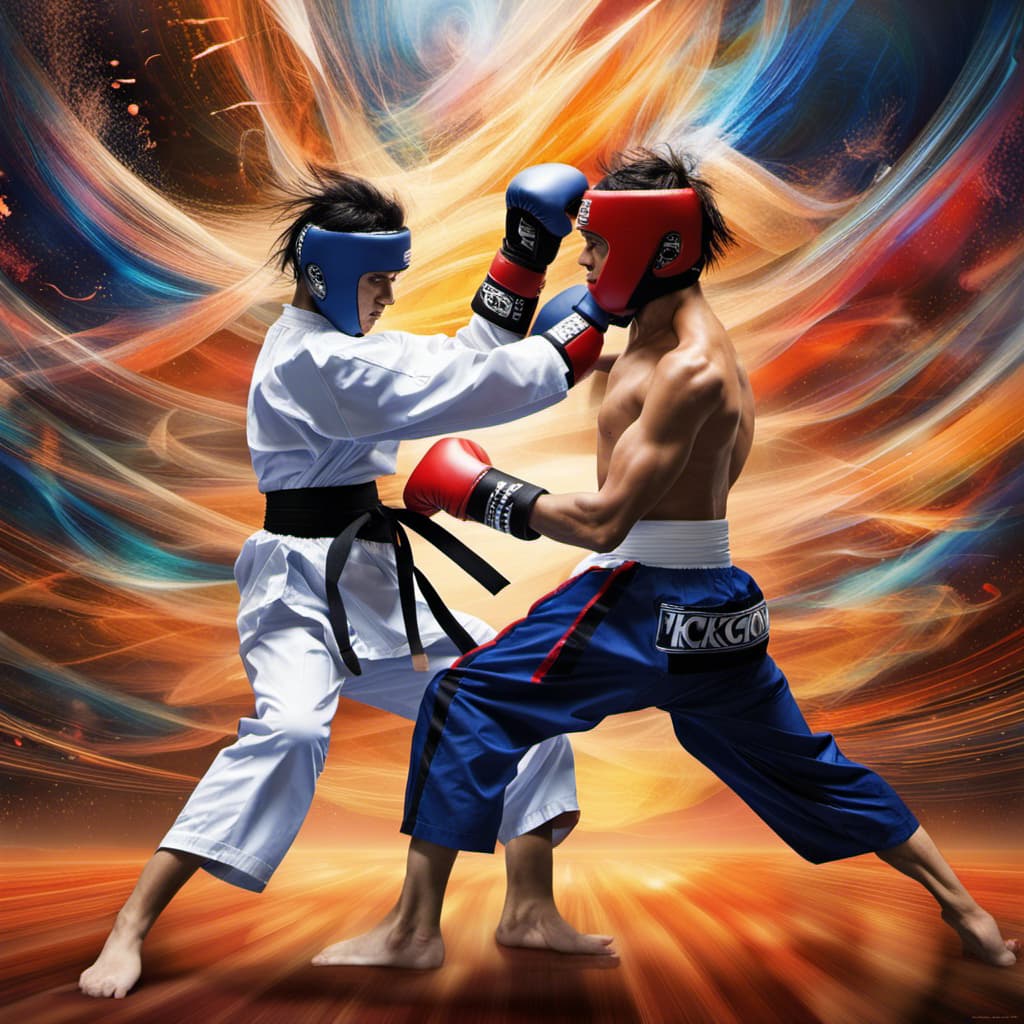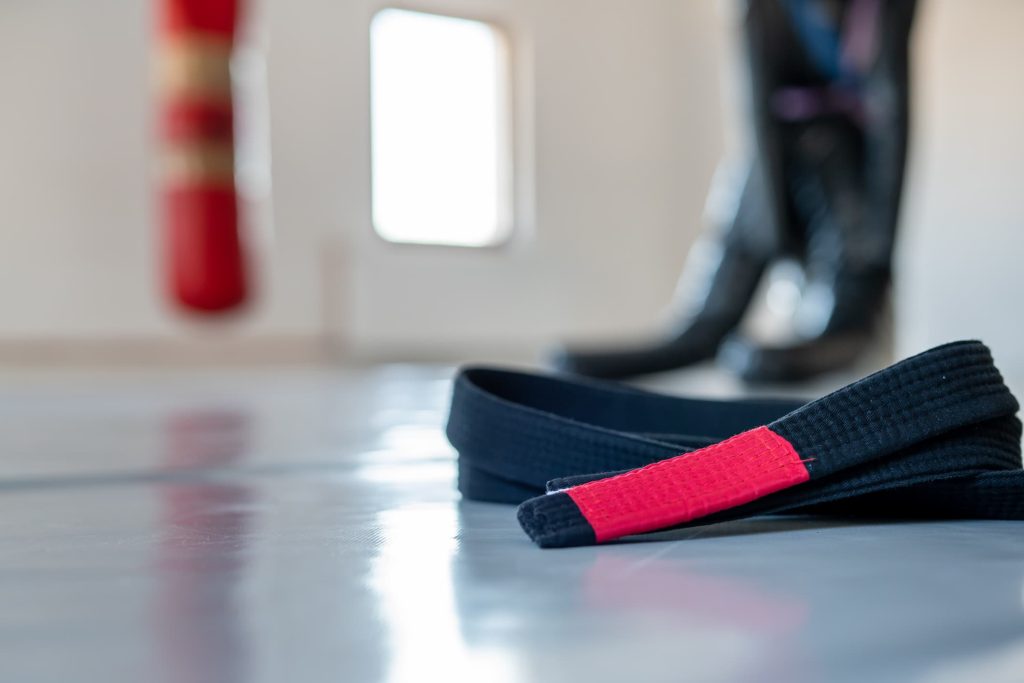- During a street fight, punches are a lot more effective than kicks, so Kickboxing, I would argue, is better than Taekwondo for self-defense.
- Personally, I would pick Taekwondo over Kickboxing because Taekwondo has a heavy focus on footwork, which establishes a strong foundation in your martial arts career.
- Understanding their differences and similarities can help individuals choose the best martial art for their goals and interests.
Kickboxing and Taekwondo are popular martial arts with unique approaches to self-defense and competition.
While they share similarities, their techniques, philosophy, and training differences make them distinct disciplines.

I will share why I would pick Taekwondo over Kickboxing and which martial arts is better for self defense.
Kickboxing, originating in Japan, combines elements of boxing and Karate for a versatile and aggressive combat sport.
On the other hand, Taekwondo, a Korean martial art, emphasizes high, fast kicks and includes formalities and rituals for a structured and disciplined approach.
Both sports offer numerous health and fitness benefits that attract many participants.
Kickboxing A Hybrid Martial Art

Kickboxing is a popular hybrid martial art that combines elements of boxing, Muay Thai, and Karate into one intense sport.
Its origins trace back to the 1970s when American full-contact karate practitioners began incorporating boxing techniques into their training.
In Kickboxing, you’ll step into the ring wearing gloves similar to boxing gloves and fight in a full-contact style. This martial art emphasizes speed, power, and precision.
The techniques you’ll learn include punches, kicks, knee strikes, and sometimes elbow strikes to outmaneuver and dominate your opponent.
Kick Boxing TRAINING:
Kickboxing requires a high fitness level and a rigorous workout targeting strength, flexibility, and cardiovascular health.
You’ll develop a strong foundation in striking techniques, defense, and movement as you train. Your hands, feet, and even your knees will become powerful tools in your arsenal.

STANCE AND MOVEMENT:
A solid stance is crucial in Kickboxing. Your feet should be shoulder-width apart and your knees slightly bent. This stance ensures stability and quick reaction time during competitions.
As you advance, you’ll learn how to quickly switch between various stances and maintain your footing, offering you an advantage in the ring.
COMPETITIONS:
In Kickboxing, bouts are fast-paced and exhilarating, aiming to either score points or achieve a knockout.
Competitions are governed by the World Kickboxing Association and other organizations, all of which have specific rules and regulations for fighters to follow.
EQUIPMENT:
Safety is paramount in Kickboxing; thus, fighters must wear appropriate protective gear. This includes gloves, shin guards, mouthguards, and sometimes headgear.
While specific matches may require a black belt, most competitions don’t mandate a particular rank.
Kickboxing offers numerous benefits, whether seeking to compete at a high level or improve your fitness and self-defense skills. By honing your techniques and physical abilities, you’ll become a more confident and capable fighter in no time.
Taekwondo A Korean Martial Art

Taekwondo is a Korean martial art that emphasizes powerful kicks and punches. It combines self-defense, art, and physical fitness elements as a traditional yet dynamic sport.
In Korea, the name Taekwondo translates to “the way of hand and foot.” It consists of Tae (foot), Kwon (fist), and Do (the way). Taekwondo practitioners focus on mastering speed, strength, and technique.
With its roots in ancient Korean martial arts, Taekwondo prioritizes respect and discipline. When training, you follow a structured curriculum under the guidance of an experienced instructor.

You’ll learn various kicking techniques, blocks, and footwork as you progress.
Besides physical abilities, Taekwondo emphasizes numerous values. You’ll develop self-discipline, mental toughness, and a strong sense of ethics through your training journey.
Many schools also teach the tenets of Taekwondo: courtesy, integrity, perseverance, self-control, and indomitable spirit.
Competition is another central aspect of your Taekwondo experience. Practitioners participate in sparring and forms to showcase their skills. While engaging in sparring matches, protective gear is vital to ensure safety.
Finally, the ranking system in Taekwondo consists of colored belts and black belts. Each color symbolizes personal growth and achievement in mastering the various techniques.
History and Evolution of this Powerful Combat Sports
Taekwondo hails from Korea and focuses on high, fast kicks. This martial art is rooted in ancient Korean traditions, and its origins date back more than 2000 years.
Over the recent decades, Taekwondo has been known worldwide as a dynamic combat sport and self-defense system. Mastering this art can help you develop incredible agility, power, and discipline.

Kickboxing started in Japan, with its origins closely tied to Karate and Muay Thai. Back in the 1950s, fighters from Japan, Thailand, and other Asian countries competed against each other in ferocious battles.
As a result, Japanese Kickboxing emerged as a hybrid martial art that integrated diverse techniques and styles.
During the late 1970s, the sport evolved further and spread across the globe, giving birth to American Kickboxing.
This new form included Western boxing, Taekwondo, and Chinese martial arts elements, transforming Kickboxing into a versatile, powerful, and fast-paced fighting form.
So, what’s the takeaway?
Both Taekwondo and Kickboxing have rich histories and offer distinctive fighting styles. Despite their differences, they share a common goal – to help you enhance your skills, strength, and confidence.
Dive deeper into these martial arts to unleash your potential and become a powerful warrior!
Techniques and Styles
Kickboxing and Taekwondo are popular martial arts but have different techniques and styles.
Punches: In Kickboxing, you’ll learn various powerful boxing techniques, such as jabs and crosses. Taekwondo also incorporates punches, but they are secondary and less emphasized.
Kicks: Taekwondo is known for its high level of kicking techniques. You’ll develop fast jumping, spinning, and other types of kicks.

On the other hand, Kickboxing includes leg kicks, roundhouse kicks, and knee strikes, prioritizing a hybrid martial art approach.
Training: You’ll notice distinct training methods in both arts. Kickboxing emphasizes strength and speed, with a focus on striking and footwork.
In contrast, Taekwondo prioritizes agility and flexibility, concentrating on kicking, stance, and quick thinking.
Defense: While both styles teach self-defense, Kickboxing combines punches, kicks, and grappling techniques. Taekwondo’s defense mainly relies on powerful kicking techniques and blocks to disarm opponents.
In summary, consider Taekwondo if you’re looking for a martial art emphasizing kicking. However, if you prefer a more balanced approach with punches and kicks, Kickboxing might be better.
Regardless of your choice, proper training and dedication are essential to mastering these martial arts.
Rules and Competition
In Taekwondo competitions, the focus is on scoring points. The aim is to score by landing accurate kicks on your opponent’s torso or head.
Taekwondo’s higher-level competition is full contact and follows strict guidelines and formalities, such as bowing and specific stances.
Kickboxing is also a full-contact combat sport. The goals here are to showcase force and ultimately knock out your opponent.

This sport allows for a combination of punches, elbow strikes, and leg kicks – all within a ring. As mentioned in this comparison, competitive Kickboxing highlights a more comprehensive range of fighting techniques.
Both sports host competitions, but the emphasis and rules differ. Taekwondo is part of the Olympic Games and emphasizes technique and accuracy.
While not in the Olympics, Kickboxing has several international championships focusing on knockout power and dominance.
When choosing between these martial arts, consider your personal preferences and how the rules align with your goals.
Don’t get me wrong, Taekwondo, whilst it is a full-contact sport during competition, you will learn that athletes are more focused on scoring the points to win rather solely focusing on knocking an opponent out! But Taekwondo is a very dangerous sport because of kicks to the head.
Whereas you will see in Kickboxing during the competition, more emphasis is placed on knocking the opponent out.
Training and Discipline
Kickboxing and Taekwondo are two distinctly different martial arts with unique approaches to training and discipline. You can expect to experience a significant change in your fitness, strength, and mental focus when practicing either.
In Kickboxing, you’ll find a high-intensity workout focusing on punches, elbow strikes, and leg kicks. This full-body workout targets strength and endurance, providing excellent results for any fitness goals.

The training is straightforward: intense sessions push your physical limits. Discipline in Kickboxing stems from maintaining form and technique throughout these challenging workouts.
Taekwondo, a Korean martial art, prioritizes agility, flexibility, and the mastery of high kicks and spinning techniques. The discipline of Taekwondo is deeply rooted in respect, both for oneself and others.
The structured training consists of forms (patterns), sparring, and self-defense techniques. Emphasis on balance and coordination is key, with a strong focus on mental discipline and concentration.
In both martial arts, sparring is crucial in honing your abilities and gaining practical experience. Controlled sparring allows you to apply your skills in real-time, further developing your strength, reflexes, and tactical thinking.
Regardless of your path, mastering either Kickboxing or Taekwondo will demand your dedication, commitment, and determination, paving the way for a healthier, more confident you.
Equipment and Gear
Kickboxing Gear: In Kickboxing, you will need boxing gloves and protective gear such as headgear, shin guards, and mouthguards.
These are important because Kickboxing is a full-contact sport to knock the opponent out. Muay Thai, a form of Kickboxing, also requires similar equipment for effective training and protection during fights.

Taekwondo Equipment: Taekwondo is also a full contact sport based on point scoring. You will use different gloves, Taekwondo-specific ones that allow better flexibility and mobility for your hands.
Along with gloves, you also need a chest protector, headgear, forearm, and shin guards, and a groin protector. High-level practitioners earn their BLACK BELT in Taekwondo, symbolizing their achievements and expertise.
Weapons in Taekwondo and Kickboxing. While both martial arts focus on hand-to-hand combat, Taekwondo incorporates traditional WEAPONS during training. However, these weapons are not typically used in Kickboxing.
In summary, when practicing Kickboxing or Taekwondo, always prioritize your safety by wearing appropriate, high-quality protective gear.
By understanding the differences in equipment between these martial arts, you can better prepare yourself for training and competition. Stay safe, and give your best on your journey toward martial arts excellence!
Differences and Similarities
Kickboxing and Taekwondo are both popular martial arts, but they have their unique characteristics. Let’s dive in and explore their differences and similarities, so you can better understand which style suits you best!
Kickboxing is a full-contact sport that emphasizes force to knock out the opponent. It has its roots in Japan and is based on Karate.
Taekwondo is also a full-contact sport based on point scoring from Korea. Taekwondo is famous for its wide variety of kicks, while punches take a secondary role.
They have distinct philosophies and equipment as well. Olympic recognition for these martial arts is different – Taekwondo is an Olympic sport, while Kickboxing is not.
However, there is a share of similarities too. Both styles provide a strong foundation for self-defense and practice discipline. In addition, you’ll improve your agility, strength, and aerobic fitness in either martial art.
By exploring these differences and similarities, you should have a clearer idea of which martial art fits your goals and preferences. So, give it a try, build your skills, and unleash your potential in martial arts!
Health and Fitness Benefits
Kickboxing and Taekwondo offer unique health and fitness benefits. Let’s dive right in and explore these martial arts’ impacts on your body.
Strength: Kickboxing strengthens your entire body. Your arms, legs, and core benefit from powerful punches and kicks. In Taekwondo, the focus is MORE on your FEET. This art is known for its high, fast, and acrobatic kicks, BUILDING lower body strength.

Agility: The rapid movements in both sports improve your AGILITY. While Taekwondo requires precise, controlled techniques, Kickboxing’s fluid punches and kicks enhance your coordination and reflexes.
Fitness: Performing nonstop moves in Kickboxing elevates your heart rate, providing an efficient cardio workout. Similarly, Taekwondo’s intense training can boost stamina and overall fitness levels.
Weight Loss: Kickboxing’s aerobic nature burns calories, aiding weight loss. Taekwondo may also contribute to weight management through its high-intensity workouts.
So, next time you’re considering a new WORKOUT regimen, think about how Kickboxing and Taekwondo can amplify your fitness journey.
Future of Kickboxing and Taekwondo
Welcome to the future of Kickboxing and Taekwondo. Both martial arts have evolved significantly, becoming prominent combat sports and cultural phenomena.
As modern martial arts, they continue to adapt and grow alongside their respective organizations and audiences.
In the world of sports, Kickboxing and Taekwondo are gaining traction. YOUR interest in these martial arts contributes to their growth, driving them toward greater heights.

Both are now recognized in national and international competitions, with numerous opportunities for enthusiasts to participate and excel.
Organizations like the World Kickboxing Association (WKA) and World Taekwondo Federation (WTF) are instrumental in guiding the future of these sports. These bodies set standards, rules, and foster talent, pushing the boundaries of what is achievable in these combat disciplines.
Modern training methods and sport-specific technology innovations will further enhance your experience as a martial artist.
Whether you’re a kickboxing or Taekwondo practitioner, you’ll benefit from state-of-the-art facilities, resources, and coaching that propel your abilities to new heights.
In conclusion, the future of Kickboxing and Taekwondo lies in the constant evolution of the sports, driven by dedicated organizations and passionate practitioners like YOU.
Embrace the journey and continue contributing to these martial arts’ ever-growing legacies!
Final Verdict
If you love kicks, it is a brainer Taekwondo is the best martial art for kicking, which has more variety of kicks, lots of speed, and quick decision-making involved, whilst kickboxing kicks are similar to muythai kicks, more thunderous powerful kicks, and also a variety of punches similar to boxing.
If you like the element of punching as well as kicking, Kickboxing is far superior to Taekwondo and I personally think it is better for self-defense because in a street fight, punches are more involved than kicks.
I like Taekwondo more as a martial art because it teaches you a variety of footwork which will give martial arts a strong foundation for any martial arts you choose to take on and give you an unfair advantage over your opponent.
Frequently Asked Questions
Which is more effective for self-defense: Kickboxing or Taekwondo?
Kickboxing is more effective for self-defense because it focuses on full-contact strikes and knockouts. Taekwondo emphasizes point-scoring with an array of spectacular kicks. However, it depends on your personal preference, training, and commitment to mastering techniques.
Which martial art is safer to practice: Kickboxing or Taekwondo?
Both sports are dangerous sports particularly when you start fighting in a competition. Taekwondo is typically known as safer to practice, as it operates on the premise of point-scoring and technique. Conversely, Kickboxing, particularly during competitions, poses a higher risk of injury due to the force of strikes and increased possibility of knockouts.
How does Taekwondo compare to Kickboxing in terms of striking techniques?
Taekwondo is known for its kicks, with numerous jumping, spinning, and creative kicking moves. Meanwhile, Kickboxing includes a balanced mix of kicks and punches derived from its foundation in Karate. Taekwondo focuses more on speed and precision, whereas Kickboxing prioritizes power and effectiveness.
Which is better for physical fitness: Kickboxing or Taekwondo?
Both martial arts offer excellent opportunities for physical fitness. Kickboxing provides a rigorous workout encompassing strength, cardio, and flexibility, while Taekwondo also improves flexibility, agility, and balance. The best choice depends on your fitness goals and preferences.
Can taekwondo techniques be incorporated into Kickboxing?
Yes, taekwondo techniques can be incorporated into Kickboxing, especially its diverse array of kicks. Adding taekwondo kicks to your kickboxing repertoire enhances your skill set, improves flexibility, and challenges both your body and mind.
Which martial art offers faster progression: Kickboxing or Taekwondo?
Progression in martial arts depends on individual effort and dedication. Typically, Kickboxing has fewer formalities, which might lead to faster progression in skills. While Taekwondo follows, a stricter syllabus with belt ranks that measure growth, persistence is key in either discipline to develop proficiency and achieve progression.



